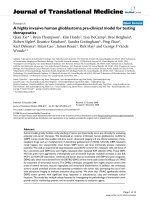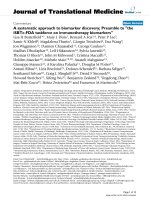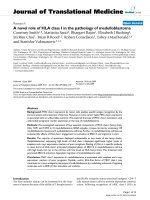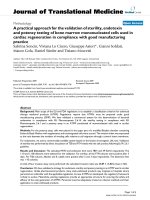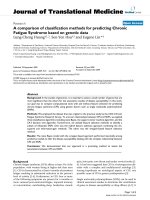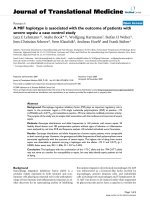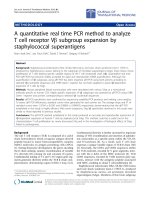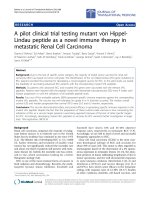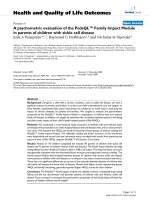báo cáo hóa học: "A pneumatic power harvesting ankle-foot orthosis to prevent foot-drop" docx
Bạn đang xem bản rút gọn của tài liệu. Xem và tải ngay bản đầy đủ của tài liệu tại đây (1.88 MB, 11 trang )
BioMed Central
Page 1 of 11
(page number not for citation purposes)
Journal of NeuroEngineering and
Rehabilitation
Open Access
Research
A pneumatic power harvesting ankle-foot orthosis to prevent
foot-drop
Robin Chin
1
, Elizabeth T Hsiao-Wecksler*
1
, Eric Loth
2
, Géza Kogler
3
,
Scott D Manwaring
1
, Serena N Tyson
1
, K Alex Shorter
1
and Joel N Gilmer
1
Address:
1
Department of Mechanical Science and Engineering, University of Illinois at Urbana-Champaign, 1206 West Green Street, Urbana,
Illinois 61801, USA,
2
Department of Aerospace Engineering, University of Illinois at Urbana-Champaign, 104 South Wright Street, Urbana, Illinois
61801, USA and
3
Clinical Biomechanics Laboratory, School of Applied Physiology, Georgia Institute of Technology, 281 Ferst Drive, Atlanta,
Georgia 30332, USA
Email: Robin Chin - ; Elizabeth T Hsiao-Wecksler* - ; Eric Loth - ;
Géza Kogler - ; Scott D Manwaring - ; Serena N Tyson - ; K
Alex Shorter - ; Joel N Gilmer -
* Corresponding author
Abstract
Background: A self-contained, self-controlled, pneumatic power harvesting ankle-foot orthosis
(PhAFO) to manage foot-drop was developed and tested. Foot-drop is due to a disruption of the
motor control pathway and may occur in numerous pathologies such as stroke, spinal cord injury,
multiple sclerosis, and cerebral palsy. The objectives for the prototype PhAFO are to provide toe
clearance during swing, permit free ankle motion during stance, and harvest the needed power with
an underfoot bellow pump pressurized during the stance phase of walking.
Methods: The PhAFO was constructed from a two-part (tibia and foot) carbon composite
structure with an articulating ankle joint. Ankle motion control was accomplished through a cam-
follower locking mechanism actuated via a pneumatic circuit connected to the bellow pump and
embedded in the foam sole. Biomechanical performance of the prototype orthosis was assessed
during multiple trials of treadmill walking of an able-bodied control subject (n = 1). Motion capture
and pressure measurements were used to investigate the effect of the PhAFO on lower limb joint
behavior and the capacity of the bellow pump to repeatedly generate the required pneumatic
pressure for toe clearance.
Results: Toe clearance during swing was successfully achieved during all trials; average clearance
44 ± 5 mm. Free ankle motion was observed during stance and plantarflexion was blocked during
swing. In addition, the bellow component repeatedly generated an average of 169 kPa per step of
pressure during ten minutes of walking.
Conclusion: This study demonstrated that fluid power could be harvested with a pneumatic
circuit built into an AFO, and used to operate an actuated cam-lock mechanism that controls ankle-
foot motion at specific periods of the gait cycle.
Published: 16 June 2009
Journal of NeuroEngineering and Rehabilitation 2009, 6:19 doi:10.1186/1743-0003-6-19
Received: 5 November 2008
Accepted: 16 June 2009
This article is available from: />© 2009 Chin et al; licensee BioMed Central Ltd.
This is an Open Access article distributed under the terms of the Creative Commons Attribution License ( />),
which permits unrestricted use, distribution, and reproduction in any medium, provided the original work is properly cited.
Journal of NeuroEngineering and Rehabilitation 2009, 6:19 />Page 2 of 11
(page number not for citation purposes)
Background
Foot-drop is a condition where the foot does not effec-
tively clear the ground due to weak or absent ankle dorsi-
flexors which results in a steppage-type gait pattern.
Steppage gait is a compensatory walking pattern for foot-
drop that is characterized by increased knee and hip flex-
ion during the swing phase to insure that the toe clears the
ground during walking. The cause of foot-drop can be
neurological and/or muscular in origin due to a multitude
of pathologies [1]. A common treatment intervention is
the use of an ankle-foot orthosis (AFO) that supports the
ankle and foot to preclude foot-drop. This study presents
a novel self-contained power harvesting ankle-foot ortho-
sis that controls the unwanted plantarflexion movements
associated with foot-drop and permits free ankle motion
during stance.
The incidence of foot-drop is difficult to determine since
it is a symptom rather than a disease; therefore numerous
pathologies may present with foot-drop as a confounding
factor. Essentially foot-drop is due to a disruption of the
motor control pathway that occurs in the brain, peroneal
nerve, spinal cord and/or muscle. Some of the common
conditions that may present with a foot-drop are: trauma,
incomplete spinal cord injuries, stroke, multiple sclerosis,
muscular dystrophies and cerebral palsy.
An effective orthosis should only provide the biomechan-
ical controls necessary to improve the functional deficit
without a perturbing effect to other normal movements
and functions. Charcot-Marie-Tooth (CMT) disease is an
inherited neurological disorder that typically presents
with weak dorsiflexors and associated foot-drop [2]. As
the plantarflexors are frequently not affected, the ideal
foot-drop AFO for CMT should permit free ankle plantar-
flexion (with mild resistance) and dorsiflexion during
stance phase and block plantarflexion during swing, i.e.,
prevent foot-drop.
Many current AFO designs used for foot-drop treatment
are effective at controlling the undesirable plantarflexion
during swing, but do not permit free ankle motion during
the stance phase of gait [3,4]. In conventional metal and
leather systems, metal hinge joints with various types of
stops are used to block motion while springs serve to resist
or assist movement. The posterior leaf spring ankle foot
orthosis is a plastic shell that encompasses the posterior
and plantar aspect of the leg and foot respectively, with
the distal half of the shank section acting as a flexible strut
(the leaf spring). These AFO's do not have articulated
ankle joints and instead are dependent upon the material
properties and geometry which determine motion control
characteristics. Because the thermoplastics (i.e. polypro-
pylene) used in these AFO strut designs have a resistive
property when they are deformed, their biomechanical
motion control is restricted to resistive and assistive func-
tions and cannot permit free movement. Hybrid AFO sys-
tems take advantage of the light weight plastic shell
designs but are equipped with an articulated ankle joint to
have a better anatomical/mechanical joint alignment and
provide more diverse motion control options (i.e. stops,
assists etc.). However, the drawback of these AFO designs
is that the motion control elements cannot be timed and
operated to different periods of the gait cycle. Therefore
many of the motion control functions are present at times
that they are not needed or even inhibit desirable motion.
A relatively small and efficient spring and oil damper
ankle joint was recently developed by Yamamoto and col-
leagues [5,6] to resist plantarflexion at initial contact and
limit plantarflexion during swing. These studies demon-
strated that an AFO outfitted with an oil damper ankle
joint effectively improved gait compared to conventional
mechanical ankle joint systems. However, the authors
acknowledged that further research was needed to
develop AFO's that could provide their own power while
ensuring compactness and portability.
Using external power supplies, orthoses equipped with
computer-driven powered actuators have demonstrated
that specific motion-control tasks can be carried out to
influence functional parameters of gait with relatively pre-
cise accuracy, e.g. [7-14]. However the applicability of
these orthoses is limited to laboratory- and clinical-based
studies since off-board power supplies and computers are
required for their operation, i.e., these are tethered sys-
tems. To respond to this need, an AFO has been devel-
oped herein which includes a self-harvesting power
system to control a mechanical ankle joint with a minia-
ture actuator. The control features of the system provide
toe clearance during swing and allow free ankle motion
during the stance phase of gait.
A novel aspect of the proposed Power-harvesting Ankle-
Foot Orthosis (PhAFO) is the capacity to re-generate
power through the compression of a bellow located in the
sole of the foot component. The pneumatic (air) power
system is designed to be charged during mid to late stance
of each gait cycle. The stored pneumatic power is designed
to drive an actuated cam-lock mechanism that prevents
plantarflexion of the foot during swing. At initial heel con-
tact, a touch-valve (air pressure release-valve) located at
the posterior plantar surface of the AFO is activated. This
valve dispels air through an exhaust port which disen-
gages the lock to allow free movement of the ankle and
foot during stance phase. Thus, the need for an external
power source and controller for the AFO can be elimi-
nated.
To test the biomechanical effects of the PhAFO during
walking, a pilot study was conducted on an unimpaired
Journal of NeuroEngineering and Rehabilitation 2009, 6:19 />Page 3 of 11
(page number not for citation purposes)
healthy control subject. The objectives of this pilot study
were to determine if the PhAFO could: (1) repeatedly har-
vest fluid power during mid to late stance during walking,
(2) use this power to actuate a cam-lock mechanism at
specific periods of the gait cycle, (3) provide adequate toe
clearance during swing, and (4) permit free ankle foot
motion during stance.
Methods
Ankle foot orthosis
The current prototype was designed as a stand-alone
device, not intended for insertion into a shoe (Fig. 1). The
PhAFO was comprised of two major components, a pos-
terior shell tibial section and a foot piece. Both parts were
custom fabricated out of a pre-impregnated carbon com-
posite laminate material over a positive model of a leg.
The foot shell (US men's size 11) incorporated a shoe-last
profile that placed the heel 1.0 cm higher with respect to
the metatarsal heads. The toe section of the foot plate was
oriented, at a five degree angle (pitch) relative to the
ground, to emulate late stance rollover since the foot sec-
tion was rigid and did not allow natural dorsiflexion of
the phalanges. Conventional free motion ankle hinge
joints connected the foot piece and tibial section. Velcro
straps were used to secure the PhAFO to the leg and foot.
The actuator and cam-lock control mechanism were
attached to the lateral aspect of the AFO. A stationary cam
was attached to the lateral upright of the tibial section and
an actuated roller-follower mechanism was affixed to the
foot piece. A foam sole was cemented to the plantar sur-
face of the foot shell. The device and attachments have a
total mass of 1 kg. (Conventional foot-drop AFOs weigh
between 300–600 g; however since these designs require
insertion into a shoe, the weights of the PhAFO and con-
ventional AFO plus shoe are comparable.)
Fluid power was harvested through a pneumatic circuit
located between the foot shell and the foam sole (Fig. 2).
The sole was comprised of four layers of 7 mm thick sheets
of polyethylene foam (Pelite™ Bakelite Xylonite Ltd, Croy-
don UK). The sole was modified to incorporate the pneu-
matic circuit for the power harvesting system (which
consisted of a bellow pump, valves, and tubing). The
pneumatic bellow pump was constructed from a single
convolution of a hypalon molded accordion bellow
(McMaster-Carr Supply Company, Aurora, Ohio, USA;
Model 9421K62) and conical compression spring
(McMaster-Carr 1692K31) that were epoxied to two poly-
carbonate plates. A 3 mm sheet of blue polyethylene foam
(MicroPuff Alimed Inc, Dedham, Massachusetts, USA)
was used to cover and permit compression and expansion
of the bellow (Fig. 1). The design, size and shape of the
bellow was based on a recent study [15], which deter-
mined the maximum achievable pressure (above 150
kPa) and maximum power generated per gait cycle (peak
levels of nearly 10 Watts). A bellow with outside diameter
of 4.5 cm was chosen for the present PhAFO since it
matched the compressed air volume required by the cylin-
der and provided the required pressure to activate the
actuator cylinder. Details of the available power and the
Posterior and lateral views of the power-harvesting AFO (PhAFO)Figure 1
Posterior and lateral views of the power-harvesting AFO (PhAFO). See Figure 2 for reference to symbols (A, R, C1,
C2).
Journal of NeuroEngineering and Rehabilitation 2009, 6:19 />Page 4 of 11
(page number not for citation purposes)
relationship between pressure and cylinder displacement
are discussed in [15], where it was noted that Boyle's Law
qualitatively described the pressure-time history based on
separate tests.
During the stance phase of walking, the weight of the
body compressed the bellow and served as the power
source for the self-contained pneumatic circuit. This
action generated work on the actuated cam-lock mecha-
nism to control plantarflexion during the swing phase.
The actuator mechanism consisted of a small linear cylin-
der with spring return (Festo Corporation, Model AEVC-
6-10-A-P), a follower with small rollers, and guide rail
housing for the follower (Fig. 1). The minimum pressure
required to move the actuator rod was empirically meas-
ured to be 120 kPa, similar to the minimum operating
pressure specified by the manufacturer. The shape of the
follower and guide rail housing prevent potentially dam-
aging shear forces from being transmitted to the cylinder
rod. Control and timing of the actuator was accomplished
through use of a release valve and the specific placement
of the bellow. The bellow was placed under the 2
nd
and 3
rd
metatarsal heads. Prior plantar pressure measurements
during walking [16,17] and empirical testing determined
that this placement achieved the best pressure generation
upon bellow compression, while also allowing optimal
timing between the release valve and actuator activation.
The locking mechanism behavior throughout the gait
cycle is detailed in Fig. 3. With the release valve located at
the posterior-plantar edge of the AFO's sole, heel strike
activates the release valve and allows the compressed air
to be discharged from the linear cylinder into the atmos-
phere (Fig. 3a). At this discharge, the spring in the cylinder
retracts the actuator rod to disengage the cam lock and
allow free ankle movement (Fig. 3b). As the foot rocks for-
ward during stance, the release valve is closed and fluid
power is harvested by compression of the bellow, allow-
ing the pneumatic circuit to be recharged. With compres-
sion of the bellow, the cylinder rod extends,
simultaneously pushing the follower into extension. Due
to the cam design, dorsiflexion during mid-stance is
allowed as the follower rolls over the cam surface (Fig.
3c). As the ankle progresses into plantarflexion during late
stance, the follower rolls into the cam locking position
and secures the foot from plantarflexing beyond the neu-
tral position during swing (Fig. 3d). Note that due to the
design of the locking mechanism, when it is engaged, the
ankle joint should ideally not be able to plantarflex or
dorsiflex away from the neutral position. In essence, both
plantarflexion and dorsiflexion are "blocked" once the
locking mechanism is engaged, thus holding the ankle
joint in the neutral position.
Biomechanical assessment of PhAFO
The design of the PhAFO was assessed using a pilot study
involving an able-bodied control subject (male, 22 years,
weight 85 kg, height 174 cm). The subject signed an
informed consent form approved by the university institu-
tional review board. Throughout all trials, the subject
walked at a self-selected pace on a split-belt instrumented
treadmill that has two independent force plates capable of
collecting ground reaction force data under each foot
(Bertec Corporation, Columbus, Ohio, USA). Average
self-selected comfortable walking speed with running
shoes was determined after using 0.05 m/s increment and
decrements, and identified to be 0.9 m/s.
To assess the influence of the PhAFO on lower limb joint
angle behavior, the subject performed two 2-minute walk-
ing trials. During the first trial (control), the subject
walked in conventional running shoes. During the second
trial (PhAFO test condition), the subject wore the PhAFO
on the right foot and a conventional running shoe on the
left. The heel height of the PhAFO was modified to insure
that it was equal to that of the running shoe. Based on our
own pilot work, the subject was given five minutes of
walking practice to adapt to the PhAFO.
Kinematic data were examined during these trials. For the
control trial, reflective markers were attached to the head,
PhAFO pneumatic circuit diagram and shoe soleFigure 2
PhAFO pneumatic circuit diagram and shoe sole.
Pneumatic circuit diagram (a) and actual foam sole (b) with
bellow pump mounted at the metatarsal. (C1) check valve is
open to atmosphere for intake, (C2) check valve ensures
one-way flow direction from bellow to actuator, (A) actuator
for locking mechanism, and (R) pressure release valve for
exhaust. Valve (R) opens to atmosphere upon contact with
the floor (c).
Journal of NeuroEngineering and Rehabilitation 2009, 6:19 />Page 5 of 11
(page number not for citation purposes)
torso, arms, and legs. Sagittal plane joint angle data for the
ankle, knee and hip were derived using the procedure pro-
posed by Vaughan et al. [18]. For the PhAFO trial, the lat-
eral malleolus, 1
st
and 5
th
metatarsal, and heel markers on
the right side were removed and markers were placed on
the PhAFO to ensure that the motion of the device was
tracked correctly. The ankle angle for the PhAFO was com-
puted using the procedure proposed by Winter [19]: two
markers were placed collinearly along the lateral aspect of
the shank section, a marker was placed lateral to the 5th
metatarsal and a marker was placed on the posterior heel
region of the PhAFO. To identify the distal end of the
shank segment, necessary to compute knee angle, two
additional markers were needed since the lateral malleo-
lus marker was removed due to obstruction by the PhAFO.
These skin markers were placed on the anterior and poste-
rior surfaces of the distal part of the shank (superior to the
ankle joint), such that the distal landmark for the shank
segment was defined as the midpoint of these markers.
Kinematic data were collected using a six camera infrared
motion analysis system sampled at 100 fps (Vicon,
Oxford, UK; Model 460). Ground reaction force (GRF)
Ankle joint actuator concept and function during a gait cycleFigure 3
Ankle joint actuator concept and function during a gait cycle.
Journal of NeuroEngineering and Rehabilitation 2009, 6:19 />Page 6 of 11
(page number not for citation purposes)
data from the treadmill were sampled at 1000 Hz. Motion
and force data were low-pass filtered at 14 Hz and 39 Hz,
respectively, using fourth-order, zero-lag, Butterworth fil-
ters, determined from the residual analysis method
described by Winter [19].
To better examine stance and swing phase mechanics,
joint angle data were separated into these two main sub-
divisions of the gait cycle. The stance phase begins at heel
strike and ends at toe-off when that same foot has left the
ground. The swing phase then lasts from toe-off until the
subsequent heel strike of the same foot. Heel strike was
defined as the instance when the vertical GRF exceeded a
threshold of 10 N. Toe-off was defined as the instance
when the vertical GRF fell below 10 N. The 10 N threshold
value was chosen to exceed the noise level of the GRF data.
All joint angle data were normalized using the gait events
such that subsequent heel strikes were adjusted to 0 and
100% of the gait cycle. Average (and standard deviation)
flexion-extension joint angle data for the ankle, knee, and
hip of the right side were computed over the entire trial.
Due to missing or obstructed markers, 83 and 95 gait
cycles were evaluated for the control and PhAFO test trials,
respectively. During the 2-minute PhAFO trial, toe clear-
ance was evaluated. For each gait cycle, the minimum dis-
tance between the bottom of the PhAFO sole and the
treadmill top surface was determined using the vertical
position of the marker aligned medial to the 1
st
metatarsal
adjusted by an offset from the marker location to the sole
of the PhAFO (48 mm).
To further evaluate repeatable toe clearance during swing
and performance of the pneumatic circuit in the PhAFO,
the subject performed one 10-minute walking trial while
wearing the PhAFO and running shoe combination. GRF
and pressure data were collected and sampled at 1000 Hz.
Kinematic data could not be collected simultaneously for
the 10-minute trial due to limitations of the motion cap-
ture system. Vertical GRF measurements were used to ver-
ify that there was no foot-ground contact during the swing
phase by the limb with the PhAFO during this longer eval-
uation trial. Custom-made pressure sensing footswitches
(constructed from force sensing resistors by Interlink Elec-
tronics Inc., Camarillo, California, USA; Model 402, 0.5"
circle) were placed in the PhAFO insole under the heel
and metatarsal heads. The footswitches were used to
examine timing and contact of the fore and rear foot dur-
ing the gait cycle (heel contact, forefoot contact, and foot-
flat). Ground reaction force data is not able to distinguish
these discrete foot contact events. A pressure transducer
(Setra Systems Inc., Boxborough, Massachusetts, USA;
Model 209) was used to record pressure in the pneumatic
circuit. The pressure profiles were captured by the pressure
transducer connected via a Y-joint to the linear cylinder.
Pressure measurements were used to verify pneumatic
power generation by the bellows, and actuation/release of
the cylinder. GRF and pressure data were processed
through a low-pass, second-order, zero-lag, Butterworth
filter with 39 Hz and 150 Hz cut-off frequencies, respec-
tively, determined from the residual analysis method
described by Winter [19].
Results
Kinematic data were used to evaluate the effect of wearing
the PhAFO on joint behavior (Fig. 4). The measurements
of the ankle angle during the gait cycle were used to quan-
tify the allowance of plantarflexion during initial contact,
free dorsiflexion during stance, and the reduction of
plantarflexion during swing. As desired, plantarflexion
was allowed after initial contact and dorsiflexion was
observed through early to mid-stance. As the gait cycle
progressed for the control trial, ankle plantarflexion
increased with the metatarsal on the ground during the
push-off and propulsion phase. However, for the PhAFO
gait trajectory, continued plantarflexion during early
swing was blocked at the neutral position (0°) as per to
the intended design. Unexpected excessive dorsiflexion
was observed during mid-swing for the PhAFO trial. The
hip and knee trajectories are important measures to deter-
mine if excess movements at these joints preempted toe
clearance rather than control from the AFO. In general the
magnitude and timing of knee and hip joint angles were
similar. The timing of the ankle motion was slightly mod-
ified by the addition of the PhAFO. A timing difference in
reaching peak dorsiflexion was noted between the control
and PhAFO conditions. Average timing for the end of the
stance phase (or toe-off) was also found to be (a) for the
control condition, 64 ± 1% for the right limb and 65 ± 2%
for the left; and (b) for the AFO test condition, 63 ± 1%
gait cycle for the right limb wearing the PhAFO, and 67 ±
1% for the left.
Kinematic, foot switch and vertical GRF data were used to
assess timing and foot position during stance and to eval-
uate foot clearance during swing while wearing the
PhAFO during level walking. During the initial contact
phase (0–2% gait cycle), the foot touches the floor, as
shown by the ground reaction force plot and activation of
the heel sensor (Fig. 5). With the heel on the ground and
acting as a rocker, the ankle plantarflexes into foot flat as
noted by the simultaneous activation of both the heel and
metatarsal sensors. Stance ends when the foot is com-
pletely lifted from the floor. At this point, ground reaction
force goes to zero and the metatarsal sensor is deactivated.
Ground reaction force remains at zero throughout the
remainder of the gait cycle suggesting toe clearance during
the swing phase. Kinematic data from the 2-minute
PhAFO trial verifies toe clearance between the PhAFO and
treadmill surface, which was found to average 33 ± 4 (SD)
mm with a minimum observed clearance of 25 mm.
Journal of NeuroEngineering and Rehabilitation 2009, 6:19 />Page 7 of 11
(page number not for citation purposes)
Ankle, knee, and hip ankle joint range of motionFigure 4
Ankle, knee, and hip ankle joint range of motion. Average (and standard deviation) ankle, knee, and hip angular trajecto-
ries for the right side of the control subject wearing the PhAFO and normal running shoe over two minute walks. Toe-off for
each condition is signified by corresponding vertical line. Positive values = flexion (dorsiflexion).
20 40 60 80 100
−20
−10
0
10
20
Ankle Angle (Deg)
20 40 60 80 100
0
20
40
60
80
Knee Angle (Deg)
20 40 60 80 100
−10
0
10
20
30
% Gait Cycle
Hip Angle (Deg)
PhAFO
Running Shoe
STDEV
Journal of NeuroEngineering and Rehabilitation 2009, 6:19 />Page 8 of 11
(page number not for citation purposes)
The performance and repeatability of the cyclical locking
and unlocking of the cam-lock mechanism during walk-
ing was verified. The results showed that the PhAFO was
able to generate and discharge air pressure for a 10-minute
period without a failure in its functional performance
(Fig. 6). The mean maximum pressure was 169 ± 14 kPa.
Charge rate of the bellows was determined to be 505 ±
103 kPa/s. The time for building up to maximum pressure
was 0.34 ± 0.06 s. After reaching a peak value, pressure
decreased gradually prior to release and followed an expo-
nential decay with decay constant 0.10 ± 0.08 s
-1
(Fig. 5).
Discussion
The design, development and testing of a portable power
harvesting ankle-foot orthosis that successfully prevents
foot-drop was presented (Fig. 1). In particular, the PhAFO
has successfully demonstrated effective control of plantar-
flexion during swing in a normal healthy subject while
also permitting free ankle movement during the stance
phase of walking (Fig. 4). This view is supported by both
kinetic and kinematic measures. Force plate data collected
during the 10-minute trial did not record any ground reac-
tion forces during swing, and kinematic data collected
during the 2-minute trial found that toe-clearance aver-
aged 33 mm with a minimum clearance of 25 mm. These
data demonstrate that no foot-ground contact occurred
and adequate toe clearance was achieved (Fig. 5). (Toe
clearance during level walking by healthy young and older
adults in normal shoes has been found to average 21 ± 5
mm, as measured by a marker over the 1
st
metatarsal head
[20].) Following initial contact, the unlocked ankle joint
allowed for full sagittal plane range of motion through
stance (plantarflexion – dorsiflexion – plantarflexion) as
noted by average ankle angle behavior (Fig. 4). Continued
plantarflexion is limited at the neutral position during
early swing due to the locking mechanism. Excessive dor-
siflexion was observed during mid-swing while wearing
the PhAFO. This dorsiflexion may have occurred as a con-
sequence of the able-bodied test subject's desire to com-
pensate for the limited plantarflexion during push-off and
unconscious concern to prevent foot-floor contact during
swing. This excessive dorsiflexion during swing should
not occur with foot-drop patients by virtue of their dorsi-
flexor weakness. This excessive fluctuation in dorsiflexion
during swing, which ideally should not have occurred due
to the locking mechanism design, illustrates a need for
additional design refinements to limit excess motion in
the dorsiflexion direction. Free dorsiflexion during stance
was also confirmed using the footswitches placed under
the heel and metatarsals (Fig. 5). These switches confirm
that both the heel and forefoot were in contact with the
ground throughout stance demonstrating that the PhAFO
did not force the subject to begin heel rise prematurely.
The capacity of the PhAFO pneumatic circuit to repeatedly
harvest fluid power during gait for the operation of the
actuated cam-lock mechanism was also validated by the
pilot study. During ten minutes of walking, the PhAFO
repeatedly pressurized and discharged the pneumatic air
circuit, cyclically locking and unlocking the mechanical
ankle joint on the orthosis at the desired periods of the
gait cycle. The bellow pump consistently generated peak
pressures over 150 kPa (Fig. 6), and always exceeded the
minimum pressure necessary to activate the linear cylin-
der, thus providing consistent actuation performance. A
small decay in pressure after the maximum pressure was
observed and attributed to the volumetric expansion of
the bellow as the foot is unloaded from the floor (Fig. 5).
The heel-mounted pressure release-valve was found to
have a near instantaneous release of pressure upon heel-
strike (Fig. 5). In general, PhAFO gait demonstrates
motion patterns and ranges of motion for each joint com-
parable to the non-AFO gait, except for the desired con-
straint in ankle motion during swing (Fig. 4). Use of the
PhAFO resulted in modest timing differences from the
control conditions. Peak dorsiflexion was reached later in
the gait cycle for the PhAFO trials; however, the general
plantar/dorsiflexion behaviors during stance were similar.
Stance-swing phase timing was also slightly different.
Stance phase tended to be shorter for the side with the
Ground reaction force and pneumatic pressureFigure 5
Ground reaction force and pneumatic pressure. Sam-
ple vertical ground reaction force (dashed line) and pressure
measured inline prior to the actuator cylinder (solid line) as a
function of percent gait cycle. Heel and metatarsal pressure
sensors indicate points of initial contact (heel sensor start),
foot flat (overlap of both sensor signals) and toe off (metatar-
sal sensor end).
0 20 40 60 80 100 120
0
100
200
300
400
500
600
700
800
900
Vertical ground reaction force (N)
% Gait cycle
0 20 40 60 80 100 120
0
20
40
60
80
100
120
140
160
180
Pressure (kPa)
Metatarsal sensor actuation
Heel sensor actuation
Journal of NeuroEngineering and Rehabilitation 2009, 6:19 />Page 9 of 11
(page number not for citation purposes)
PhAFO (63% gait cycle) than the contralateral limb (67%
gait cycle) or control gait (64%). Timing was modified
such that toe-off occurred as the ankle joint approached
the neutral position (0°) during the AFO trial; whereas
during the control trial, toe-off occurs after full plantar-
flexion occurs (approximately -10°). This timing differ-
ence is due to the locking of the ankle joint in the neutral
position. Further, use of the PhAFO did not substantially
modify knee and hip movement and timing behavior.
Knee and hip flexion was comparable between condi-
tions; therefore, toe clearance appears to be related to the
adequate ankle foot position that the orthosis provided.
A limitation of conventional mechanical ankle joints is
that their control mechanisms cannot be timed to the gait
cycle to switch function. Thus, a control mechanism that
blocks motion often is sustained throughout the gait
cycle, thereby sacrificing normal functional movement
elsewhere. Such limitation can cause deviations from nor-
mal ankle-foot dynamics and could lead to reduced gait
stability and efficiency. The proposed PhAFO overcomes
this limitation. The design advances demonstrated with
the PhAFO are the ability to restrict plantarflexion during
swing while permitting free ankle motion during stance,
and the capacity to harvest pneumatic power to control
these functions. Through use of a mini-actuator to drive a
novel cam-lock mechanism, motion control at different
times in the gait cycle is possible. The most notable of
these advances is the capability for self-power using a
pneumatic bellow since this feature allows untethered
operation and control of the orthosis. The high forces gen-
erated through walking are ideally suited for harvesting
fluid power. Multiple channel pneumatic circuits and
Multiple step pressure profileFigure 6
Multiple step pressure profile. Pressure profile over multiple gait cycles demonstrating repeated pressure generation from
the bellow pump and release at heel strike.
0 5 10 15 20
0
50
100
150
200
Time (s)
Pressure (kPa)
Journal of NeuroEngineering and Rehabilitation 2009, 6:19 />Page 10 of 11
(page number not for citation purposes)
additional actuators could provide further orthotic con-
trol options and features.
Recently, Takaiwa and Noritsugu [21] reported the devel-
opment of a prototype for another portable pneumatic
power-harvesting AFO that supports the foot during
swing. The purpose of their design was to reduce falls in
older adults by mitigating stumbling associated with shuf-
fling gait. They prevent foot-drop by producing a dorsi-
flexion-assist moment at the ankle. To do this, their
orthotic system used a much larger pneumatic bellow
pump located under the heel of a shoe to pressurize a long
linear cylinder that powered an actuator. For our study, we
elected to use the passive ankle motions during stance
phase to engage a compact cam-lock that blocked plantar-
flexion during swing. Hence, power-assisted dorsiflexion
was not necessary. Since this work is a pilot study, this
research has several limitations that should be considered
when interpreting these findings. Only one able-bodied
control subject was used for this initial evaluation. To
determine the efficacy of the design, a more thorough
clinical investigation using patients diagnosed with foot-
drop would be required. As noted, the locking mechanism
needs refinement to limit excess motion in the dorsiflex-
ion direction when engaged. Future work is also necessary
to examine possible effects of the PhAFO on gait symme-
try by examining the contralateral leg behavior when uni-
lateral AFO use is studied. Several design issues that were
not undertaken in this project are also limitations. The
additional biomechanical control feature to 'dampen'
plantarflexion just after initial heel contact was not
addressed in this prototype. Another design choice was
whether an in-shoe or external system would serve as the
platform for the prototype. Since a major objective was to
self-harvest power, a prototype design with an outsole was
chosen because of its capacity to house the bellow, valve
and tubing components compared to the space con-
straints of an in-shoe type device. Future work is necessary
to reduce this design to an in-shoe device.
Conclusion
The findings from this study demonstrate that fluid power
can be harvested with a bellow pump and pneumatic cir-
cuit in an AFO to operate a cam-lock mechanism that con-
trols ankle-foot motions at specific periods of the gait
cycle. Conceptually, fluid power appears to have potential
as a control and power source for use in lower extremity
orthotic applications. Considerable research and develop-
ment is still needed to determine if fluid power can aug-
ment and enhance contemporary orthotic systems, and
how the technological advantages can be maximized to
advance current clinical treatments. The miniaturization
of components is an important aspect of future study in
this area and is being addressed by our research team.
Competing interests
An invention disclosure, with intent to obtain a patent in
the United States, has been submitted to the University of
Illinois at Urbana-Champaign.
Authors' contributions
All authors contributed to the conception and design of
the device. RC developed the bellows concept, con-
structed the tested device, conducted and analyzed the
biomechanical testing data, and drafted the manuscript.
ETHW co-supervised the project, assisted with the devel-
opment and implementation of the biomechanical test-
ing procedure, and helped to draft the manuscript. EL co-
supervised the project and helped to draft the manuscript.
GK oversaw design of the structural shell and sole, assisted
with the development of the biomechanical testing data,
and helped to draft the manuscript. SDM developed the
cam-locking mechanism. SNT developed the pneumatic
circuit and identified valves. KAS assisted with the struc-
tural shell, analysis and interpretation of the biomechan-
ical testing data, and editing of the manuscript. JNG
modified the sole and cam design, and assisted with
device construction and collection and analysis of the bio-
mechanical testing data. All authors read and approved
the final manuscript.
Acknowledgements
Funding for this research was from NSF grant #0540834 and the Center for
Compact and Efficient Fluid Power (CCEFP). The authors would like to
thank Prof. Andrew Alleyne, Prof. Manak Lal Jain, Louis DiBerardino, Lau-
ren Merry, Josh Porter, and Jason Thomas for their assistance and valuable
discussions.
References
1. Perry J: Gait analysis: normal and pathological function Thorofare, NJ:
Slack; 1992.
2. Newman CJ, Walsh M, O'Sullivan R, Jenkinson A, Bennett D, Lynch B,
O'Brien T: The characteristics of gait in Charcot-Marie-Tooth
disease types I and II. Gait Posture 2007, 26:120-127.
3. American Academy of Orthopaedic Surgeons: Atlas of orthoses and
assistive devices 3rd edition. St. Louis: Mosby; 1997.
4. Lusardi MM, Nielsen CC: Orthotics and prosthetics in rehabilitation Bos-
ton: Butterworth-Heinemann; 2000.
5. Yamamoto S, Hagiwara A, Mizobe T, Yokoyama O, Yasui T: Devel-
opment of an ankle – foot orthosis with an oil damper. Pros-
thet Orthot Int 2005, 29:209-219.
6. Yokoyama O, Sashika H, Hagiwara A, Yamamoto S, Yasui T: Kine-
matic effects on gait of a newly designed ankle-foot orthosis
with oil damper resistance: A case series of 2 patients with
hemiplegia. Arch Phys Med Rehabil 2005, 86:162-166.
7. Banala SK, Kulpe A, Agrawal SK: A Powered Leg Orthosis for
Gait Rehabilitation of Motor-Impaired Patients. IEEE Interna-
tional Conference on Robotics and Automation Rome, Italy
2007:4140-4145.
8. Blaya JA, Herr H: Adaptive control of a variable-impedance
ankle-foot orthosis to assist drop-foot gait. IEEE Trans Neural
Syst Rehabil Eng 2004, 12:24-31.
9. Boehler AW, Hollander KW, Sugar TG, Shin D: Design, implemen-
tation and test results of a robust control method for a pow-
ered ankle foot orthosis (AFO). IEEE International Conference on
Robotics and Automation. Pasadena, CA, USA 2008:2025-2030.
10. Ferris DP, Czerniecki JM, Hannaford B: An ankle-foot orthosis
powered by artificial pneumatic muscles. J Appl Biomech 2005,
21:189-197.
Publish with BioMed Central and every
scientist can read your work free of charge
"BioMed Central will be the most significant development for
disseminating the results of biomedical research in our lifetime."
Sir Paul Nurse, Cancer Research UK
Your research papers will be:
available free of charge to the entire biomedical community
peer reviewed and published immediately upon acceptance
cited in PubMed and archived on PubMed Central
yours — you keep the copyright
Submit your manuscript here:
/>BioMedcentral
Journal of NeuroEngineering and Rehabilitation 2009, 6:19 />Page 11 of 11
(page number not for citation purposes)
11. Gordon KE, Ferris DP: Learning to walk with a robotic ankle
exoskeleton. J Biomech 2007, 40:2636-2644.
12. Norris JA, Granata KP, Mitros MR, Byrne EM, Marsh AP: Effect of
augmented plantarflexion power on preferred walking speed
and economy in young and older adults. Gait Posture 2007,
25:620-627.
13. Oymagil AM, Hitt JK, Sugar T, Fleeger J: Control of a Regenerative
Braking Powered Ankle Foot Orthosis. IEEE 10th International
Conference on Rehabilitation Robotics. Noordwijk, The Netherlands
2007:28-34.
14. Sawicki GS, Domingo A, Ferris DP: The effects of powered ankle-
foot orthoses on joint kinematics and muscle activation dur-
ing walking in individuals with incomplete spinal cord injury.
J Neuroeng Rehabil. 2006, 3:3.
15. Chin R, Loth E, Hsiao-Wecksler ET: Fluid-power harvesting by
pneumatic bellow during human gait. 8th International Sympo-
sium on Fluid Power, ASME Fluids Engineering Conference. Jacksonville, FL
2008.
16. Cavanagh PR, Ae M: A technique for the display of pressure dis-
tributions beneath the foot. J Biomech 1980, 13:69-75.
17. Fong DT, Mao DW, Li JX, Hong Y: Greater toe grip and gentler
heel strike are the strategies to adapt to slippery surface. J
Biomech 2008, 41:838-844.
18. Vaughan CL, Davis BL, O'Connor JC: Dynamics of Human Gait 2nd edi-
tion. Cape Town, South Africa: Kiboho Publishers; 1999.
19. Winter AD: Biomechanics and Motor Conbtrol of Human Movement 3rd
edition. Hoboken, NJ: John Wiley & Sons; 2005.
20. Menant JC, Steele JR, Menz HB, Munro BJ, Lord SR: Effects of walk-
ing surfaces and footwear on temporo-spatial gait parame-
ters in young and older people. Gait Posture 2009, 30(1):65-70.
21. Takaiwa M, Noritsugu T: Development of pneumatic walking
support shoes using potential energy of human. 7th Japanese
Fluid Power Society International Symposium on Fluid Power. Toyama, Japan
2008.
